Solar eclipse of June 11, 2048
| Solar eclipse of June 11, 2048 | |
|---|---|
 Map | |
| Type of eclipse | |
| Nature | Annular |
| Gamma | 0.6468 |
| Magnitude | 0.9441 |
| Maximum eclipse | |
| Duration | 298 sec (4 m 58 s) |
| Coordinates | 63°42′N 11°30′W / 63.7°N 11.5°W |
| Max. width of band | 272 km (169 mi) |
| Times (UTC) | |
| Greatest eclipse | 12:58:53 |
| References | |
| Saros | 128 (60 of 73) |
| Catalog # (SE5000) | 9615 |
An annular solar eclipse will occur on June 11, 2048. A solar eclipse occurs when the Moon passes between Earth and the Sun, thereby totally or partly obscuring the image of the Sun for a viewer on Earth. An annular solar eclipse occurs when the Moon's apparent diameter is smaller than the Sun's, blocking most of the Sun's light and causing the Sun to look like an annulus (ring). An annular eclipse appears as a partial eclipse over a region of the Earth thousands of kilometres wide.
Images
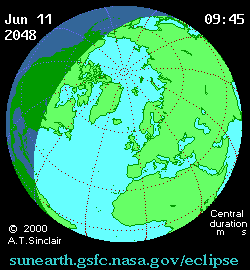
Animated path
Related eclipses
Solar eclipses of 2047-2050
Each member in a semester series of solar eclipses repeats approximately every 177 days and 4 hours (a semester) at alternating nodes of the Moon's orbit.
Note: Partial lunar eclises on January 26, 2047 and July 22, 2047 occur on the previous lunar year eclipse set.
| Solar eclipse sets from 2047-2050 | ||||
|---|---|---|---|---|
| Ascending node | Descending node | |||
| 118 | June 23, 2047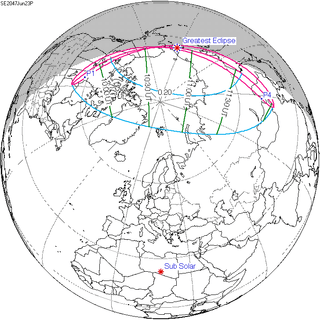 Partial |
123 | December 16, 2047 Partial | |
| 128 | June 11, 2048 Annular |
133 | December 5, 2048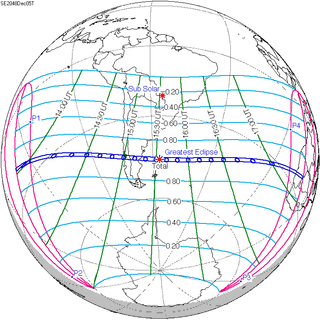 Total | |
| 138 | May 31, 2049 Annular |
143 | November 25, 2049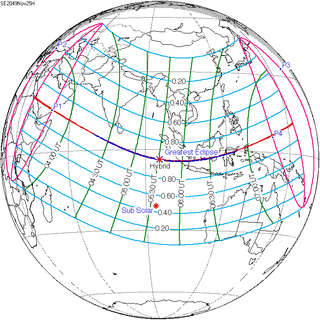 Hybrid | |
| 148 | May 20, 2049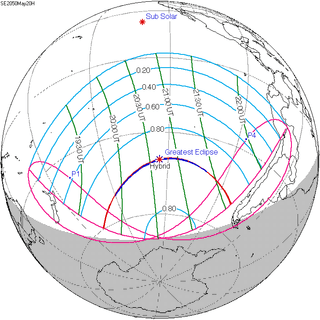 Hybrid |
153 | November 14, 2050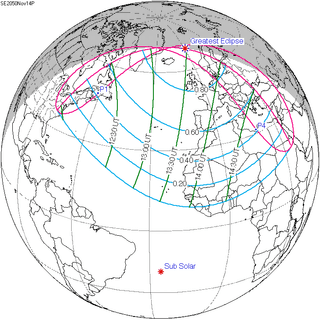 Partial | |
Saros 128
It is a part of Saros cycle 128, repeating every 18 years, 11 days, containing 73 events. The series started with partial solar eclipse on August 29, 984 AD. It contains total eclipses from May 16, 1417 through June 18, 1471 and hybrid eclipses from June 28, 1489 through July 31, 1543. Then it progresses into annular eclipses from August 11, 1561 through July 25, 2120. The series ends at member 73 as a partial eclipse on November 1, 2282. The longest duration of totality was 1 minutes, 45 seconds on June 7, 1453.[1]
| Series members 52–62 occur between 1901 and 2100 | ||
|---|---|---|
| 52 | 53 | 54 |
 March 17, 1904 |
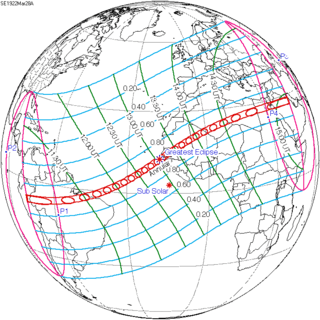 March 28, 1922 |
 April 7, 1940 |
| 55 | 56 | 57 |
 April 19, 1958 |
 April 29, 1976 |
 May 10, 1994 |
| 58 | 59 | 60 |
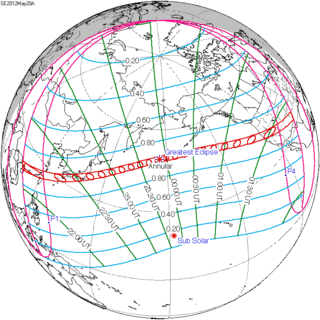 May 20, 2012 |
 June 1, 2030 |
 June 11, 2048 |
| 61 | 62 | |
 June 22, 2066 |
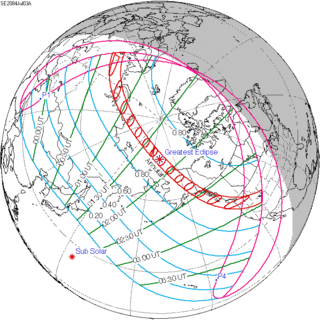 July 3, 2084 | |
References
| Wikimedia Commons has media related to Solar eclipse of 2048 June 11. |
